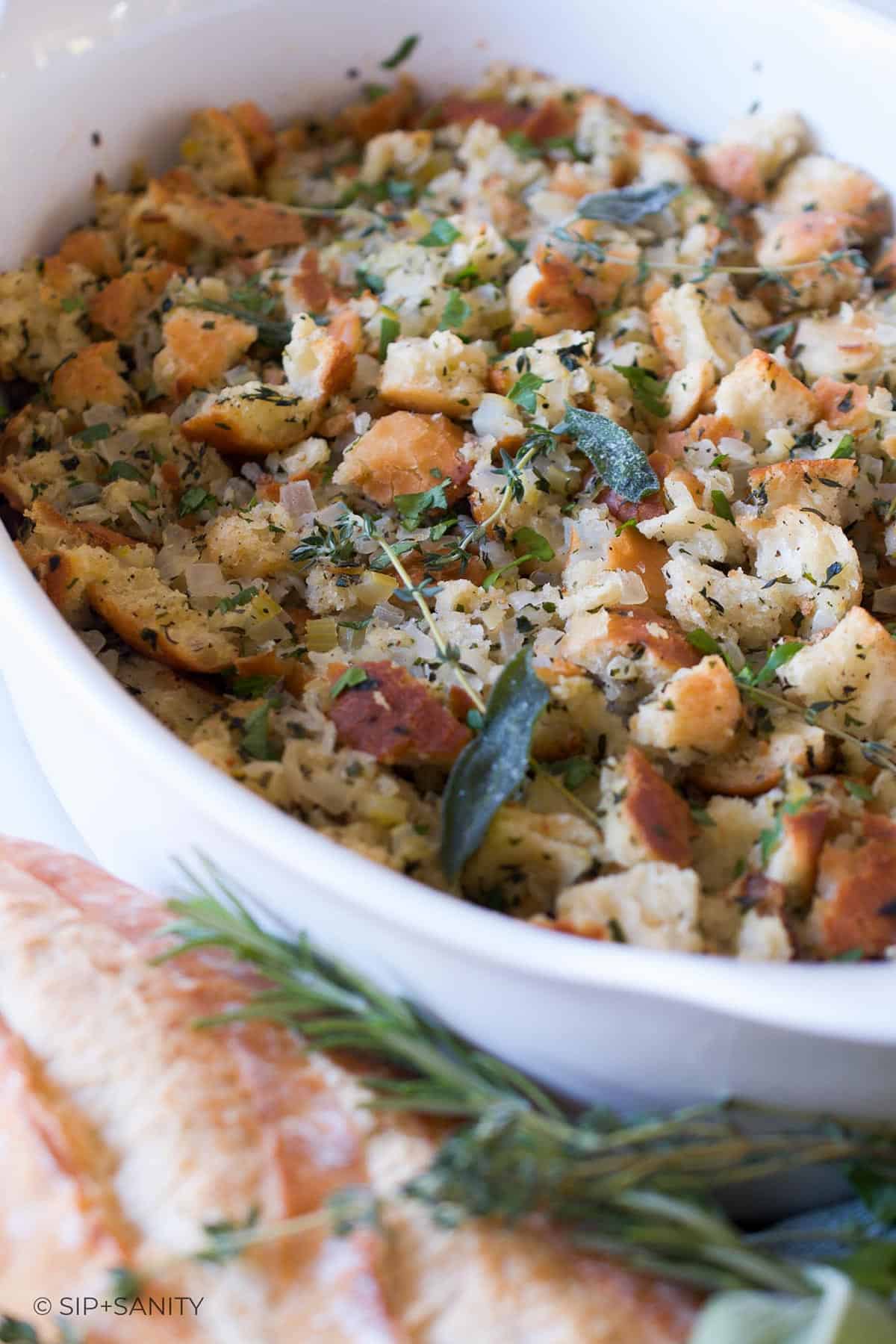Old Fashioned Thanksgiving Dressing with Fresh Herbs
This Old Fashioned Thanksgiving Dressing recipe is brimming with fresh herbs and wholesome ingredients. It will transport you to cherished holiday traditions with each savory bite!

Old Fashioned Thanksgiving Dressing Recipe
Back when I was a poor college student, I used to buy Stove Top box stuffing mix to enjoy at home all year round. I was a little obsessed. It was also cheap and required little cooking ability…I had zero at the time.
Now that I’m comfortable in the kitchen, and prefer cooking from scratch (mostly), a homemade stuffing recipe is a must for our Thanksgiving Day gathering! This recipe uses wholesome, simple ingredients to create that classic flavor you’ve come to expect in a traditional stuffing. The best part? It’s nearly as easy as opening a box of stuffing mix…nearly. 😉
Dressing vs. Stuffing
Oh…and yea, I’m using stuffing and dressing interchangeably. Force of habit.
To keep it simple, dressing is a stand alone dish; assembled and baked separately. Stuffing is used to fill the cavity of a bird and is roasted together, absorbing all the juices from the bird.
You CAN use this recipe to stuff your turkey! Just be sure that it reaches an internal temperature of 165°F before you enjoy.

Ingredients for An Old Fashioned Bread Stuffing
In addition to kosher salt and fresh cracked black pepper, you’ll need…
- Stale bread – or day old bread (see Helpful Recipe Tips below). The type of bread is ultimately up to you depending on the flavor and texture you desire in your dressing…white bread, sourdough bread, wheat bread. My preference is a crusty French bread; a rustic baguette with a strong crispy exterior and a crumb that is chewy with holes of varying sizes (not a uniform, super-soft interior).
- Unsalted butter – so you can control the amount of salt. The aromatics get sautéed in butter until soft.
- Aromatics – yellow onion, celery, fresh garlic.
- Herbs – fresh parsley, sage, rosemary, thyme and marjoram (substitute dry marjoram if you can’t find fresh; see the recipe card for measurements); dry poultry seasoning.
- Chicken broth – or chicken stock or vegetable broth. I prefer low-sodium for more control over the seasoning.

Steps to Make This Classic Stuffing Recipe
- Sauté the aromatics – melt butter in a large skillet over medium heat. Add chopped onions and celery, plus a pinch of salt and pepper. Cook for 5 minutes, then add the garlic and cook for another minute. Toss in the fresh and dry herbs and cook for another couple of minutes to release their flavors.
- Combine bread and seasonings – in large bowl, combine the aromatics and bread cubes until the onion-herb mixture is well distributed. Season to taste with salt and pepper.
- Add broth – gradually pour the broth over the dry stuffing, mixing after each addition to make sure all the bread pieces are being moistened. If the bread mixture seems too dry, add more broth as needed.
- Bake the dressing – transfer the dressing to a prepared baking dish and cover with aluminum foil. Bake for 30 minutes at 350°F; remove the foil and bake for an additional 15 minutes.

Helpful Recipe Tips
Bread Matters
- Day-old or stale bread is drier than fresh. Dry bread is more absorbent and will be able to soak up the flavorful broth, aromatics and herbs without getting too mushy. Because fresh bread still contains a lot of moisture, using it increases the risk of an overly soggy, unappetizing dressing.
- To dry out fresh bread, you have a couple of options. At least one day before, spread bread pieces out in a single layer on a sheet pan or two and leave it uncovered on your counter so the moisture can evaporate for using the next day. The other way is to place those sheet pans in a 200°F oven and bake out the moisture; check the bread every 8 to 10 minutes until it feels dry enough. If you’re hit with a wall of steam when you open the oven door, just keep baking. Cool the bread before using.
- Cubed versus torn bread? I’ve made this recipe with both and I prefer torn bread. I love the craggy edges and the overall texture of the finished bake. However, torn bread takes a little extra time, so here’s what I suggest: find a comfortable place to sit with the sheet pans, the bread, a glass of wine, your favorite tunes…and tear away!
How Much Liquid is Too Much?
It’s important to get the amount of broth right so you have a perfectly textured, but not soggy dressing. In testing, 3 cups was just right for me. However, depending on the climate you live in, the conditions of your home, how dry your bread actually is, and how moist you like your dressing…well, you may have to adjust.
Use your senses to get it just right for you:
- You can always add more liquid, but can’t take it away, so that’s why you should add the broth gradually.
- The bread should be moistened, but still hold its shape, be a little firm and stick a bit to other pieces of bread and aromatics.
- If you’re still unsure, start with less broth. When you remove the foil after the initial bake, check the consistency by poking around at it. Too separate and dry? Drizzle a bit more broth evenly over the dish and continue baking without the foil.

Storing and Reheating Thanksgiving Dressing
Cool leftover dressing to room temperature and transfer to an airtight container (or several smaller for individual portions) within two hours. Store in the refrigerator for 3 to 4 days. If you can’t enjoy your leftover stuffing within that time, freeze it for 1 to 3 months.
Reheat leftovers in the microwave or oven until very hot (or it reaches an internal temp of 165°F). Thaw frozen leftovers before reheating.
Fun Uses for Leftover Dressing
Leftover Thanksgiving dinner is great, but sometimes its fun to repurpose your leftovers and give them new life! Here are a few ideas:
- Make stuffing stuffed bell peppers – trim off the tops and remove the seeds and membranes. Mix the stuffing with a little cheese and fill the peppers, then bake. (You can do this with portobello mushroom caps, acorn squash, and tomatoes, too!)
- Make stuffing waffles – combine dressing with beaten egg and cook in a waffle maker until crisp and hot. Serve with gravy or cranberry sauce.
- Turn it into a strata – combine with greens, like baby spinach or leftover brussels sprouts, cheese, and several beaten eggs then bake in a casserole.
- Stuff into chicken breasts or pork chops – create a pocket in the meat and fill with dressing. Bake or sauté and serve with gravy or make a pan sauce.
- Make a pot pie – sauté a package of mixed frozen vegetables with diced onion and some seasonings. Toss in leftover roast turkey or rotisserie chicken. Mix with leftover gravy or a velouté. Pour it into a casserole dish and top with a layer of leftover dressing then bake. (I can personally attest that this is a quick and delicious pot pie hack!)

More Recipes for Your Thanksgiving Table
- French Onion Green Bean Casserole
- Roasted Rainbow Carrots
- Cornbread Stuffing Stuffed Mushrooms
- Roasted Garlic Mashed Potatoes
- Brussels Sprouts + Pancetta Breakfast Strata

Old Fashioned Thanksgiving Dressing with Fresh Herbs
Ingredients
- 1 pound day-old rustic french baguette, torn into small pieces (or your preferred bread)
- ½ cup unsalted butter (1 stick)
- 1 medium onion, finely chopped
- 2 stalks celery, finely chopped
- 2 cloves garlic, minced
- ¼ cup fresh parsley, chopped
- 2 tablespoon fresh sage, chopped
- 2 tablespoon fresh rosemary, chopped
- 2 tablespoon fresh thyme, chopped
- 1 tablespoon fresh marjoram, chopped (or 1 tsp dried)
- ½ teaspoon poultry seasoning
- ½ teaspoon kosher salt
- ½ teaspoon fresh cracked black pepper
- 3 cups low-sodium chicken broth, or vegetable broth (plus more, if needed)
Instructions
- Preheat your oven to 350°F (175°C) and grease a 9×13-inch baking dish.
- Transfer the dry bread pieces to a large mixing bowl.
- In a large skillet, melt the butter over medium heat. Add the chopped onion, celery and pinch or two of salt + pepper to the skillet and sauté for about 5 minutes until they become tender and translucent. Stir in the minced garlic and sauté for an additional minute until fragrant.
- Add the herbs to the skillet with the sautéed aromatics. Cook for another 2-3 minutes, stirring occasionally, to release the flavors of the herbs.
- Pour the sautéed onion mixture over the bread cubes in the mixing bowl. Season with salt and black pepper to taste.
- Gradually pour broth over the bread mixture. Gently toss to combine. The bread should be moistened but not overly soggy. Add more broth if necessary depending how you like your dressing; as the dressing bakes it will absorb all the broth and puff up.
- Transfer the dressing mixture to the greased baking dish and spread it out evenly.
- Cover the dish with aluminum foil and bake for 30 minutes. Remove the foil and continue baking for an additional 15 minutes to crisp up the top.
Notes
- To dry out bread: Day ahead – spread bread pieces out in a single layer on a sheet pan or two and leave it uncovered on your counter so the moisture can evaporate for using the next day. Quick method – spread bread pieces out in a single layer on a sheet pan or two in a 200°F oven and bake out the moisture; check the bread every 8 to 10 minutes until it feels dry enough. If you’re hit with a wall of steam when you open the oven door, just keep baking. Cool the bread before using.
- Liquid Notes: You can always add more liquid, but can’t take it away. Mix broth into the bread mixture gradually so you can guage the moisture level. When you remove the foil after the initial bake, check the consistency. If it seems too dry, drizzle a bit more broth evenly over the dish and continue baking without the foil.
- Storing Leftovers: Cool leftover dressing to room temperature and transfer to an airtight container (or several smaller for individual portions) within two hours. Store in the refrigerator for 3 to 4 days. If you can’t enjoy your leftover stuffing within that time, freeze it for 1 to 3 months.
- Reheating: Reheat leftovers in the microwave or oven until very hot (or it reaches an internal temp of 165°F). Thaw frozen leftovers before reheating.
- Stuff Your Bird: You CAN use this recipe to stuff your turkey! Just be sure that it reaches an internal temperature of 165°F before you enjoy.
Nutrition
Pin for Later! Old Fashioned Thanksgiving Dressing





